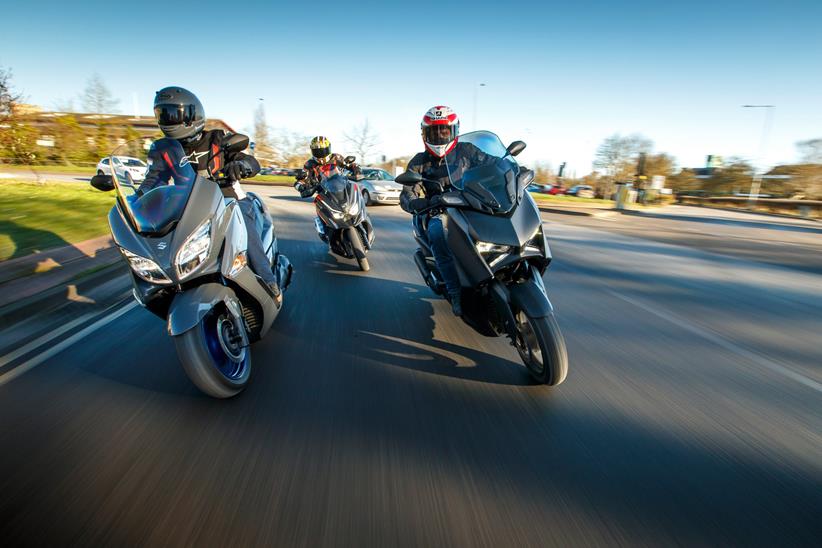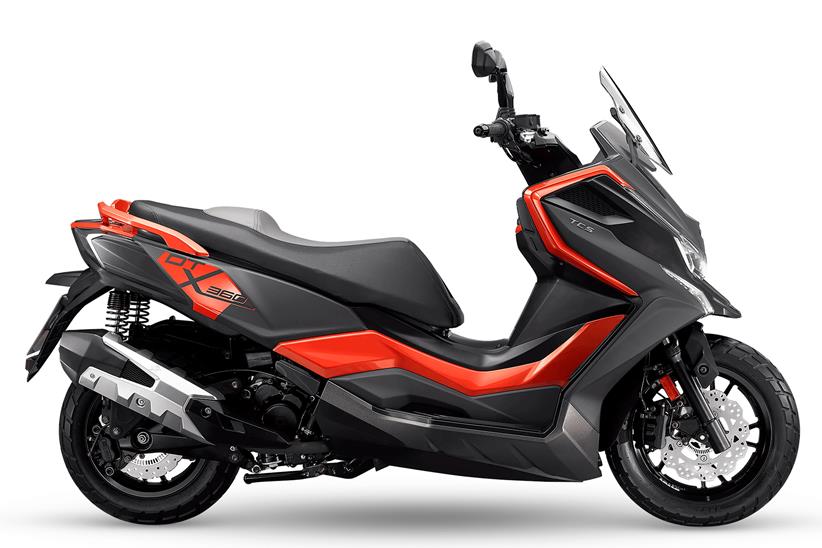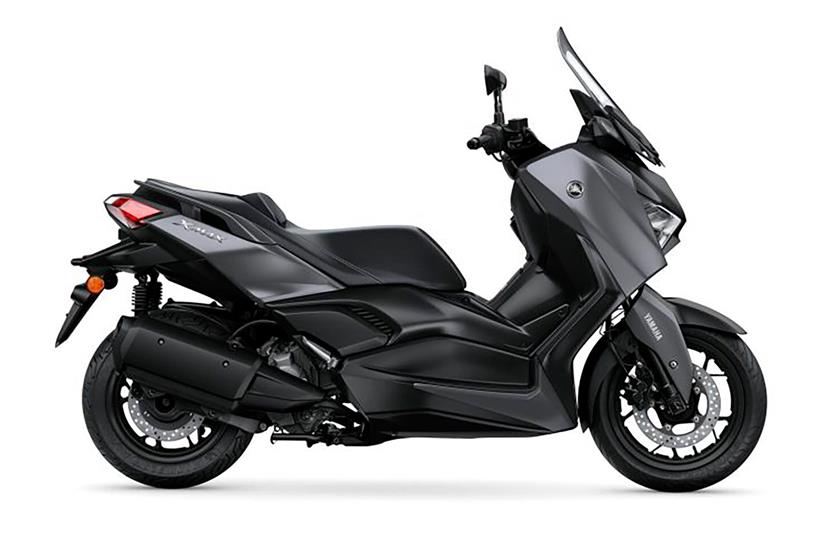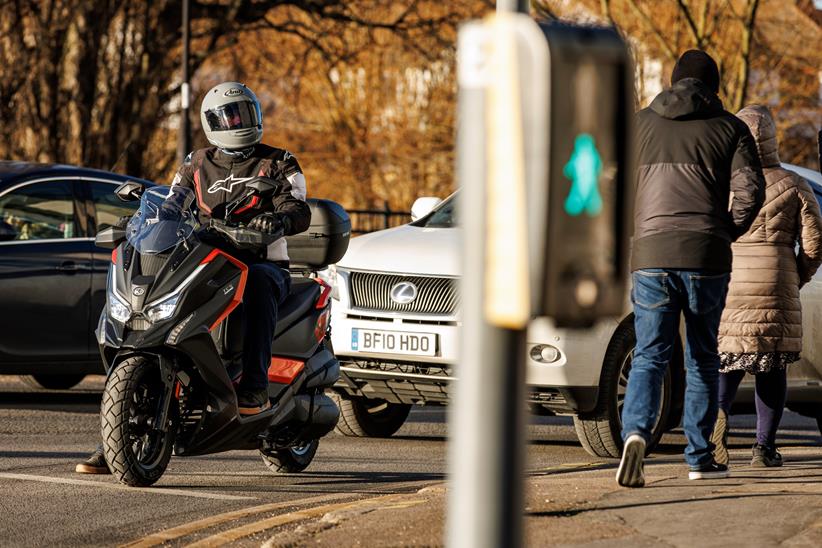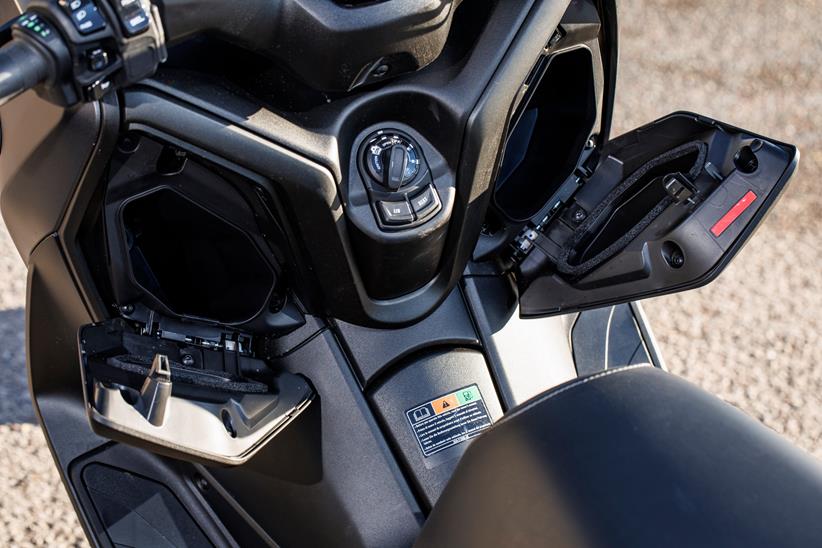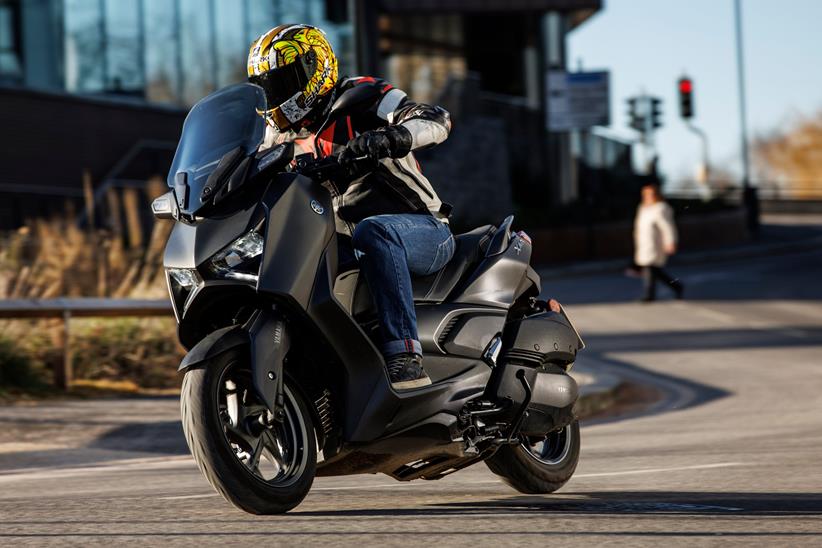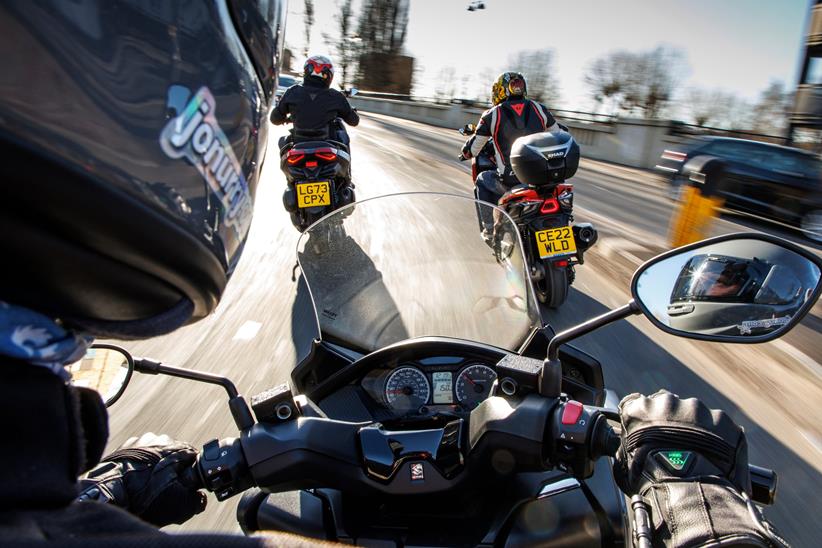Why mid-size scooters offer the best of everything around town
There is a tendency to assume mid-size scooters are an unpopular choice of two-wheeled transport in the UK. While European cities seem packed full of scoots, with everyone from teenagers to glamorous ladies about town opting for them over public transport, when you look at sales stats and data, we aren’t actually that far behind the curve.
Last year a total of 24,577 scooters of 125cc and above were sold in the UK, which is only a few hundred short of the total number of naked bikes registered and over 3000 more than new registrations of adventure bikes.
That makes them a substantial percentage of the UK’s overall two-wheeled sales of 107,215 units in 2023. But, despite a range of capacities on offer the vast majority sold are 125s.
In fact, Yamaha sell roughly 4000 NMAX 125s compared to around 400 XMAX 300s in the UK. So, faced with this data, why do midi-scooters such as the three on test today still exist? That’s all down to our continental chums.
Fast facts – dive into the detail
Yamaha XMAX 300 – £6205

- Engine 292cc liquid-cooled single SOHC 4v, 27.6bhp, 21.4 lb.ft
- Frame Tubular steel
- Suspension F: Telescopic forks, non-adjustable. R: Twin shocks, five-stage adjustable preload
- Front brake 1 x 267mm disc with two-piston caliper. ABS
- Rear brake 1 x 245mm disc with one-piston caliper. ABS
- Seat height 795mm
- Kerb weight 183kg
- Read: Yamaha XMAX 300 review
Suzuki Burgman 400 – £7199
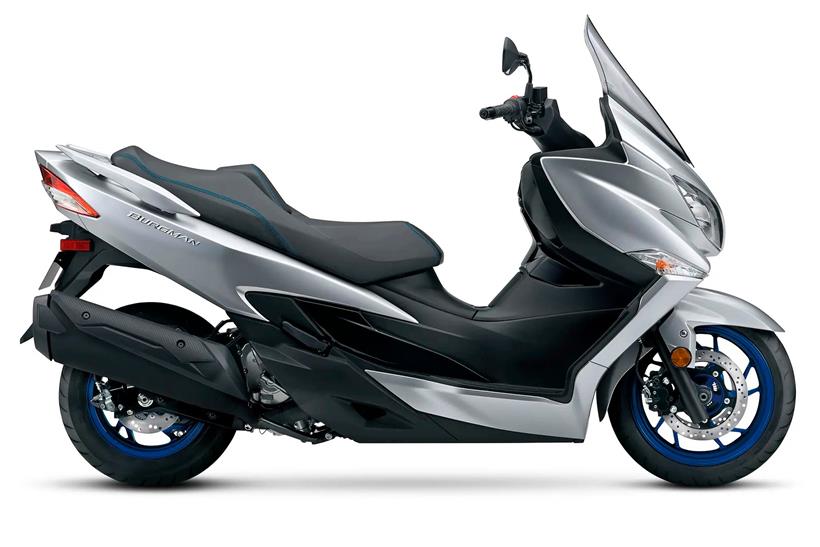
- Engine 399cc liquid-cooled single DOHC 4v, 28.6bhp, 26 lb.ft
- Frame Tubular steel
- Suspension F: 41mm telescopic forks, non-adjustable. R: Monoshock, seven-stage adjustable preload
- Front brake 2 x 260mm discs with two-piston calipers. ABS
- Rear brake 1 x 210mm disc with one-piston caliper. ABS
- Seat height 755mm
- Kerb weight 218kg
- Read: Suzuki Burgman 400 review
Kymco DTX360-320

- Engine 321cc liquid-cooled single SOHC 4v, 28.2bhp, 22 lb.ft
- Frame Tubular steel
- Suspension F: Telescopic forks, non-adjustable. R: Twin shocks, five-stage adjustable preload
- Front brake 1 x 280mm wave disc with three-piston caliper. ABS
- Rear brake 1 x 260mm disc with one-piston caliper. ABS
- Seat height 800mm
- Kerb weight 207kg
Taking the middle way
In Europe, and especially Italy and Spain, midi-scooters are hugely popular. Italian and Spanish youngsters grow up surrounded by a scooter culture that sees them, quite rightly, regarded as a sensible answer for getting around.
If you live outside a city and the public transport network isn’t that reliable or extensive, why wouldn’t you hop on a scooter? And midi scooters are far better at covering miles than a 125 while considerably cheaper than a maxi-scooter, which is why so many riders pick them.
On paper this makes them sound like the best of all worlds. But are they? And should we be buying more of them? Time to find out as we hit the suburbs, city centre and commuter roads on three popular choices. Starting our commute from the suburbs, the initial signs are good for the midi-scooters. Pop the seats up to explore their storage capacity, which is an essential part of scooter ownership, and it’s all very impressive.

The old warhorse of the test, the Suzuki Burgman 400, has two handy cubbyholes (neither are lockable) and a deep underseat storage compartment, which is enough to swallow one full-face lid but not two. Raise the seat on the semi-adventure styled Kymco DTX360-320 and the news is better as it boasts enough storage for two lids and has a single (non-lockable) cubbyhole (as well as an additional topbox), while the Yamaha XMAX 300 trumps them all with massive underseat cap-acity that easily takes two lids, plus there are two cubbyholes, one of which is lockable.
If you want to nip to the shops or office and not feel limited by carrying capacity, the XMAX has you covered the best with the DTX360 a close second and the Burgman third. Seat storage areas loaded with woolly hats and gloves and we are off on the first leg of our commute, A-roads and dual carriageways.
Time to hit the road…
There is a tendency to think that small-wheeled scooters such as these aren’t built for fast commuter riding, yet that’s the joy of a midi-scooter. All of these bikes have A2-legal engines making just short of 30bhp, giving them enough poke to keep up with traffic while also feeling far more assured than a 125cc scooter. On a busy dual carriageway you can happily hold 70mph and not feel like you are thrashing them to death. In fact,
both the Yamaha and Suzuki will top 80mph if you desire. But, crucially, they do so with stability, so that when you pass a lorry you don’t suffer that horrible heart-in-mouth moment when the turbulence hits you and you are buffeted around like a pinball.

The Suzuki deals with this environment noticeably better than the others. On a dual carriageway you can’t help but appreciate the extra size and weight of the Burgman. Longer and considerably heavier than both the Yamaha and Kymco (by 35kg in the case of the Yamaha!), it is rock-solid at speed and feels unflappable. Where the lighter XMAX can get pushed about a bit by sidewinds and the Kymco feels slightly skittish at over 60mph (mainly due to its tyres), the Burgman motors on unhindered.
You could happily cover a daily 30 or more mile dual carriageway commute on the Suzuki and do so in complete comfort thanks to its relaxed riding position, which is noticeably longer and more stretched out in the leg area than the upright-stance offered by the Yamaha or Kymco. Would you need to resort to a scooter apron as well? Thankfully both the Burgman and XMAX offer enough weather protection for you to avoid this humiliation, however the DTX360 rider may wish to invest in a sturdy

set of textiles as its adventure styling sees its rider far more exposed to the elements and its small screen is pretty ineffective. So when it comes to straight lines the Burgman leads the way; would the tables turn as the traffic builds up? Time to find out as we hit the urban jungle.
City slickers?
Entering a busy city centre the Burgman instantly feels more of a lump than the XMAX and DTX360.
Small, light and easily manageable, the Yamaha has a lovely natural balance about it that sees it leading the way when it comes to carving through congestion.
Many assume larger scooters are cumbersome at slow speed but this is far from the case, with low centres of gravity these midi-scoots are perfect for zipping through traffic, feeling only marginally heavier than a 125, and their twist-and-go throttles make them far less effort than a traditional motorcycle engine with a clutch and gearbox.

In a city centre the XMAX feels right at home, changing direction quickly and accelerating instantly to allow you to take advantage of any gaps in the traffic. If you need to get across a city, few machines will allow you to do so with as much speed and ease as the Yamaha XMAX. And that list includes the Kymco and Suzuki.
Frustratingly, as on the dual carriageway, in town the DTX360 felt hampered by its tyres. To be fair to the Kymco the roads were quite cold and slimy but the knobbly-style CST tyres it came on were simply dreadful, making it feel lazy to turn and lacking in grip. It was the only bike that lost front wheel grip while cornering during the whole day (all three have traction control on the rear and ABS as standard) and that was mainly down to its rubber.

A change to a more premium brand of tyres should be right at the top of the shopping list if you opt for the DTX360 – alongside a new indicator warning noise (if that’s even possible…) as the pinging one it comes with as standard is hideous.
As for the Suzuki, it’s not bad in a busy city, far from it, it’s just not as agile as the Yamaha. There again, the Burgman is targeted at an urban rider who wants a luxurious-feel where the XMAX hits the sporty scooter segment, so a slight lack of agility at the expense of comfort is to be expected. And it has to be said, Suzuki have really thought through the finer details of the Burgman – which they have had plenty of time to do as it has been around in some shape or form since 1998.
When you park up, small things please you about the Suzuki. Undeniably a bit old-school with its key ignition (the Yamaha and Kymco are both keyless), there is no faffing about when you want to release the Suzuki’s seat or fuel cap as you just turn the key, whereas on the XMAX and DTX360 it’s a bit more of a fiddle.

There is also a neat ignition cover on the Suzuki as well as a ‘lock gate’ in the bodywork to make using a chain to secure the bike a breeze. There’s even a handbrake, but the Suzuki’s twin analogue dials look very dated compared to the Kymco and Yamaha’s LCD displays, there is no connectivity as on the XMAX and, while having a key is nice, you quickly miss the convenience of keyless, especially when it is cold and you are wearing thick gloves.
Price matters
If the Burgman were cheaper you might forgive it its old-school approach but it’s £1000 more than the Yamaha and nearly £2000 more than the Kymco. And it’s not even cheaper to run, recording 52mpg over a variety of riding conditions where the Kymco averaged 62mpg (there is a definite suspicion about the accuracy of its trip) and Yamaha 57mpg.
It is worth noting, however, that the used values of both Burgmans and XMAX models tends to be quite strong, certainly better than Kymcos, so there are some savings to be clawed back here.

After completing our commuting route on all three of these bikes, I can’t help but wonder why midi-scooters aren’t more popular in the UK. Compared to a similar-style 125 they only cost about £1000 more, but deliver a vastly more assured and versatile form of transport if you need to ride a medium-length commute that includes dual carriageways as well as urban roads. In an age where more and more are moving away from city centre living, that makes them seem the ideal solution to delivering cost-effective urban transport.
The MCN verdict
If you live 30 to 40 miles from a busy city and need to commute into its heart for work, midi-scooters make absolute sense. In fact, they are probably the perfect commuting tool.
Cheaper to own than a maxi-scooter and much more assured on faster roads than a 125cc option, midi-scooters deliver the best of both worlds. Huge underseat storage, traction control, ABS, connectivity (on the Yamaha), twist-and-go motors and comfortable riding positions all add up to machines that ensure your commute is as stress-free as possible. And cheap too, with 60mpg achievable relatively low PCP payments. But which is our winner?

As stylish and well-priced as the Kymco is, its handling and lack of weather protection let it down. And despite its luxurious ride quality and excellent dual-carriageway manners, the Suzuki just felt a bit too much of a lump in town. So victory goes to the XMAX 300. Great value, practical and agile enough to carve through traffic yet still stable on a dual carriageway.
Pros:
- Roomy Burgman
- XMAX storage
- All three are practical
Cons:
- CST tyres on the Kymco
- The Burgman is dated
- Kymco’s indicator noise
Mid-size scooters: more options
If you want a scooter with more power than a 125, there are several options. Alongside the XMAX 300, Yamaha sell the XMAX 300 Tech MAX, which adds a bit of bling to the XMAX 300’s platform in the shape of a TFT dash that can act as a GPS screen as well as some extra bolt-on parts. It costs £500 more than the basic XMAX 300 at £6705.
There is also the three-wheeled (two at the front) Tricity 300, which is £8410.
BMW’s sporty C400X starts from £6560, while the more luxurious C400GT begins at £7340.
Honda are quite strong in the midi-scooter market with the £5849 Forza 350, adventure-styled £5849 ADV350 and more basic £5449 SH350i while Piaggio have the £5100 Beverly 300, £6000 Beverly 400 and the three-wheeled £6500 MP3 300, £9200 MP3 400 and £10,750 MP3 530.
Sym sell the £4999 Joymax Z+ 300 and £5499 Cruisym 300 while Peugeot have the £7349 XP400 Allure, £7449 Allure GT and three-wheeled £8949 Metropolis Allure.
On the maxi-scooter front, the Yamaha TMAX Tech MAX is £14,007 but boasts a 560cc parallel twin motor alongside loads of tech and a sporty chassis with inverted forks and radial brakes.
The 400 is the only remaining Burgman model in Suzuki’s range but Kymco make the three-wheeled CV3 for £10,999 or the AK550 maxi-scooter for £9999, both of which use a 550cc parallel twin.
Honda’s Forza 750 is £10,499 and X-ADV £11,199, which have a 745cc parallel twin motor, and there is also the £8499 Sym Maxsym TL 508, which is another parallel twin, this time sporting 508cc.
While you’re here: How MCN tests bikes
Our highly experienced team of road testers grind out hundreds of miles, come rain or snow, on the UK’s pothole-ridden roads to decide which bike is best in a particular category.
Using years of riding and racing experience (on and off-road), our expert journalists are able to assess the capabilities of a machine and translate that into understandable language to help MCN’s readers make an informed buying decision. Pitching bikes against their main rivals, we aim to give a conclusive verdict on which bike is best for your needs and your budget.
Using their considerable knowledge of the motorcycling market and audience, they can put a motorcycle into context and deliver a verdict that means something to anyone considering buying a particular machine, whether it be a cutting-edge, 200bhp sportsbike, a tall adventure weapon or a low-capacity 125cc machine.
When we ride the bikes in the UK we tend to do at least one full day of riding on various different types of road and in varying conditions. Our testers will then spend another day riding the bike – with rivals – to get images and video footage for our print and online reviews.
We will also, often, weigh the bikes, speed and dyno test them to see just how accurately the manufacturer claims are in these areas to give a more empirical assessment.
